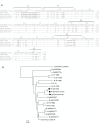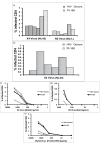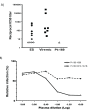Prolonged control of replication-competent dual- tropic human immunodeficiency virus-1 following cessation of highly active antiretroviral therapy
- PMID: 22141397
- PMCID: PMC3293762
- DOI: 10.1186/1742-4690-8-97
Prolonged control of replication-competent dual- tropic human immunodeficiency virus-1 following cessation of highly active antiretroviral therapy
Abstract
Background: While initiation of highly active antiretroviral therapy (HAART) during primary HIV-1 infection occasionally results in transient control of viral replication after treatment interruption, the vast majority of patients eventually experience a rebound in plasma viremia.
Results: Here we report a case of a patient who was started on HAART during symptomatic primary infection and who has subsequently maintained viral loads of < 50 copies/mL for more than nine years after the cessation of treatment. This patient had a high baseline viral load and has maintained a relatively high frequency of latently infected CD4(+) T cells. In addition, he does not have any known protective HLA alleles. Thus it is unlikely that he was destined to become a natural elite controller or suppressor. The mechanism of control of viral replication is unclear; he is infected with a CCR5/CXCR4 dual-tropic virus that is fully replication-competent in vitro. In addition, his spouse, who transmitted the virus to him, developed AIDS. The patient's CD4(+) T cells are fully susceptible to HIV-1 infection, and he has low titers of neutralizing antibodies to heterologous and autologous HIV-1 isolates. Furthermore, his CD8(+) T cells do not have potent HIV suppressive activity.
Conclusion: This report suggests that some patients may be capable of controlling pathogenic HIV-1 isolates for extended periods of time after the cessation of HAART through a mechanism that is distinct from the potent cytotoxic T lymphocyte (CTL) mediated suppression that has been reported in many elite suppressors.
Figures







References
-
- O'Connell KA, Bailey JR, Blankson JN. Elucidating the elite: mechanisms of control in HIV-1 infection. Trends Pharmacol Sci. 2009;30:631–637. - PubMed
-
- Lamine A, Caumont-Sarcos A, Chaix ML, Saez-Cirion A, Rouzioux C, Delfraissy JF, Pancino G, Lambotte O. Replication-competent HIV strains infect HIV controllers despite undetectable viremia (ANRS EP36 study) AIDS. 2007;21:1043–1045. - PubMed
Publication types
MeSH terms
Substances
Grants and funding
LinkOut - more resources
Full Text Sources
Medical
Research Materials

